November 2020 Issue
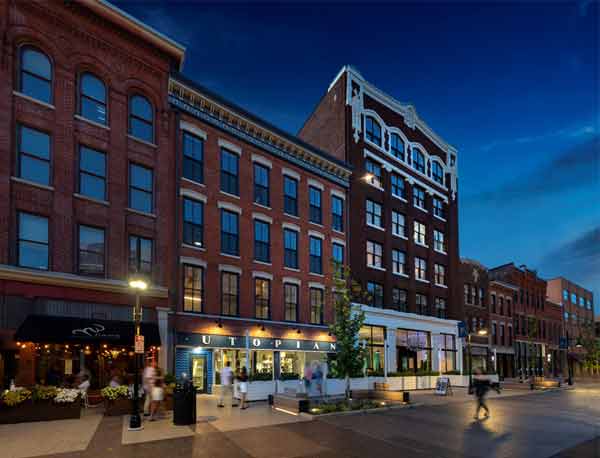
The Landing, Fort Wayne, Allen County.
DNR to honor historic preservation standout
Standouts in preserving cultural resources were presented Indiana Historic Preservation Awards at small individual 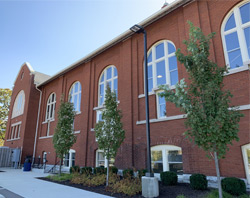 ceremonies this fall. Awards are usually presented at the annual statewide historic preservation conference, but because of the pandemic, the conference was canceled.
ceremonies this fall. Awards are usually presented at the annual statewide historic preservation conference, but because of the pandemic, the conference was canceled.
The awards were presented to:
Indiana Archaeology Award: Archaeologist Ryan Peterson; Historic Preservation Award: Decay Devils, Inc.; Outstanding Grant-Assisted Rehabilitation Award: The Indiana Medical History Museum; Outstanding Rehabilitation Tax Credit Project: Point Comfort Underwriters, Inc.; Indiana Cemetery Award: Indianapolis Airport Authority.
Read about their projects.
Grants to preserve local history across state
The Department of Natural Resources (DNR) helps strengthen Indiana’s historical and cultural heritage through annual federal matching grants it awards to communities and not-for-profit groups to assist local preservation projects.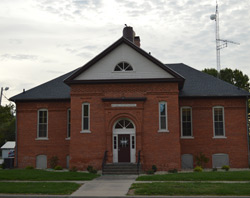 This year, the DNR Division of Historic Preservation & Archaeology has awarded 14 federal Historic Preservation Fund grants totaling more than $481,000 for historic preservation and archaeology projects in Indiana communities. In most cases, these grants require a dollar-for-dollar match of local or private funds, for a total projected investment of $929,000 in these important cultural resource projects.
This year, the DNR Division of Historic Preservation & Archaeology has awarded 14 federal Historic Preservation Fund grants totaling more than $481,000 for historic preservation and archaeology projects in Indiana communities. In most cases, these grants require a dollar-for-dollar match of local or private funds, for a total projected investment of $929,000 in these important cultural resource projects.
Funding comes from the National Park Service, a unit of the U.S. Department of the Interior, which distributes federal funds to the states through its Historic Preservation Fund Program. Since 2000, the state has awarded $11 million to assist more than 500 important heritage preservation projects across Indiana. When combined with local matching funds, this represents investment of more than $23 million into preservation of Indiana’s heritage.
Angola: The Powers Church and Cemetery Association; Bloomington: The Monroe County Government; Chesterfield: The Friends of Camp Chesterfield; Huntington: The City of Huntington; Indianapolis: The Indianapolis Propylaeum; Monticello: The Twin Lakes School Corporation; Morgan-Monroe Counties: Ball State University’s Applied Anthropology Laboratories; Muncie: Cornerstone Center for the Arts; New Albany: The Floyd County Historical Society; Tippecanoe County: The University of Indianapolis; Vincennes: The City of Vincennes.
Read about the grants and projects they will fund.
Start planning now for the 2021 Historic Preservation Month photo contest
While you are out enjoying the lovely fall weather, be on the lookout for those eye-catching views of Indiana’s historic 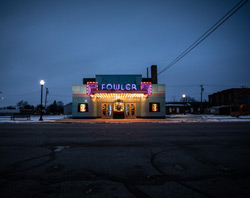 resources and take a few pictures. The DHPA will again be sponsoring another digital photo contest to celebrate Historic Preservation Month in 2021.
resources and take a few pictures. The DHPA will again be sponsoring another digital photo contest to celebrate Historic Preservation Month in 2021.
For the second year, printed photos will no longer be accepted. Instead, JPEG files (less than 10MB) and entry forms should be emailed to aborland@dnr.IN.gov as attachments.
Photographers can submit up to three photos, but please only attach one photo and entry form per email so files do not exceed size limits of state email accounts.
Also, be sure to follow the DNR Instagram (@indianadnr) account in May—the DHPA will be doing a takeover and featuring selected photos along with contest winners.
Read the rules, guidelines and get an entry form.
Residential Planning and Development in Indiana, 1940-1973 form now available
DHPA has published a sampling of post-war neighborhoods that have been determined to be eligible for the National Register of Historic Places. These windshield survey forms were generated and evaluated as part of our successful effort to have Alan Higgins’ Multiple Property Documentation Form (MPDF), Residential Planning and Development in Indiana, 1940-1973 accepted by the National Register. These are not all the neighborhoods that are eligible under the MPDF, but we hope they will provide a spectrum of neighborhoods that will be useful.
The windshield forms are grouped by the Indiana regions used as an analytical tool within the MPDF: Calumet, Falls of the Ohio, Indianapolis Metro, Vanderburgh County, and Vigo County.
Cancellation of Preserving Historic Places 2020
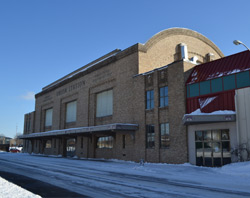 Because of the pandemic, stay at home orders, and budget restraints, the Preserving Historic Places has been canceled for 2020. Organizers are already looking to 2021 (we’ll be staying in South Bend) and planning for the next conference. Everyone, stay safe and we’ll see you next year.
Because of the pandemic, stay at home orders, and budget restraints, the Preserving Historic Places has been canceled for 2020. Organizers are already looking to 2021 (we’ll be staying in South Bend) and planning for the next conference. Everyone, stay safe and we’ll see you next year.
In lieu of an in-person conference in 2020, Preserving Historic Places has been offering a series of free virtual sessions on a variety of preservation topics. Even if you missed the live webinar, they are all recorded and can be viewed at any time. Learn more .
Rehabilitation of The Landing Historic District in Fort Wayne using the Federal Historic Tax Credit
In 2017 the rehabilitation of seven buildings in The Landing Historic District in Fort Wayne began. The developer of these properties, The Model Group (Cincinnati), used the Federal Historic Tax Credit Program to aid in their rehabilitation work, and as of August 2020 all seven properties have received certification for their credits from the National Park Service. The Landing Historic District was listed on the National Register of Historic Places on September 16, 1993 and is located in downtown Fort Wayne, just a block northwest of the Allen County Courthouse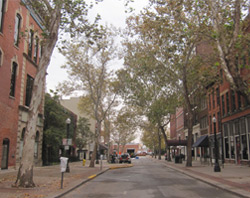 . It is a compact district only spanning about two city blocks with a total of just 22 resources within its boundaries. Therefore, this project to rehabilitate seven buildings has made a large impact on the small district and will go a long way in revitalizing the area, which had seen a steep decline in activity in recent years.
. It is a compact district only spanning about two city blocks with a total of just 22 resources within its boundaries. Therefore, this project to rehabilitate seven buildings has made a large impact on the small district and will go a long way in revitalizing the area, which had seen a steep decline in activity in recent years.
The seven buildings that were rehabilitated are the Moellering Building (110-112 W. Columbia Street), the Volland Mills Building (114 W. Columbia Street), 116 W. Columbia Street, the Fishers Brothers Paper Building (118 W. Columbia Street), 122-124 W. Columbia Street, the Pinex Company Building (123-125 W. Columbia Street), and the Nickel Plate Hotel (131 W. Columbia Street). The total project costs totaled over $24 million with over $3 million awarded for qualified expenses under the Federal Historic Tax Credit Program. The completed buildings contain a mix of uses, including 46 housing units (with 11 low/moderate income units), office space, restaurants and commercial spaces.
If you would like to learn more about The Landing Historic District (NR-0102), the full National Register of Historic Places nomination is available in the SHAARD database, which can be accessed on our website.
For more information on the Federal Historic Tax Credit, visit our website.
New Listings on the National Register of Historic Places for Indiana
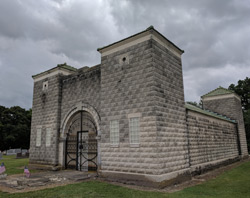 From April 2020, through October 2020, Indiana added 17 listings to the National Register of Historic Places. These listings—houses; commercial and industrial buildings; religious buildings; a farm; a park; a cemetery and mausoleum; and historic districts—have added approximately 767 historic resources to the national and state registers. Get information on Indiana properties listed in the National Register of Historic Places and the Indiana Register of Historic Sites and Structures here.
From April 2020, through October 2020, Indiana added 17 listings to the National Register of Historic Places. These listings—houses; commercial and industrial buildings; religious buildings; a farm; a park; a cemetery and mausoleum; and historic districts—have added approximately 767 historic resources to the national and state registers. Get information on Indiana properties listed in the National Register of Historic Places and the Indiana Register of Historic Sites and Structures here.
Read the entire list of newly listed properties.
Highlighting Indiana’s Archaeology
The DHPA is launching a new public archaeology program to share archaeology information with Hoosiers. A digital document is being created to highlight an archaeological site from each of Indiana’s 92 counties. By also involving archaeology colleagues, who volunteered to write the features for a general audience, this also helps the professional archaeology community share with the public their research, finds, and experiences.
Highlighting Hoosier Archaeological Sites: Examples from 92 Counties will be a StoryMap on the division’s webpage, where viewers will be able to click on a county and read about the featured site. In the future, additional sites and case studies per county may also be added. In the StoryMap documents, we try to minimize the technical details and summarize the facts into a simple format, integrating photographs, diagrams, and maps where possible to better educate and inform the public about the practice and significance of archaeology around Indiana. We thank our many archaeology colleagues who have thus far contributed to the project.
We will let you know when the StoryMap is available and hope you will check out this exciting new public archaeology initiative. A sample of one of the featured sites is included here .
New Archaeology Outreach Pieces
The archaeology staff has been working on various new outreach pieces to explain Indiana’s history and how archaeology can be used to help further interpret this history. Topics from native peoples in the state to one-room schoolhouses can better be understood through archaeology. Spend some time reading about Indiana history and archaeology with our various resources.
Work Adjustments
Like many other businesses and government agencies in 2020, the staff at the DHPA have adjusted to a new working schedule. Since the initial state shutdown in March, DHPA staff have primarily been working remotely and have adjusted some internal procedures in coordination with federal agencies, consultants, and the public.
The Environmental Review Section started accepting submissions electronically understanding that working remotely may result in a lack of necessary supplies to print and submit reports in hard copy. For now, we still accept electronic submissions (and always accept hard copy).
The Archaeology Team was sad to miss out on in-person connections usually made during Archaeology Month this September. We look forward to next year’s Archaeology Month and being able to engage with the public again.
The Survey/National Register Section now submits NRHP nominations to NPS electronically but will still send hard copies and archival CDs. The next Historic Preservation Review Board meeting will be in January 2021; currently it is only viewable live. In the meantime, revisions to the style guide will include more information on postwar resources, and we hope to restart the county survey program in 2021.
The Grants Section shifted to email communications with grant recipients to receive progress reports, reimbursement requests, and review project plans and contracts. Start-up meetings for FY2020 Historic Preservation Fund grants were conducted remotely by video conference or conference call. No changes were made to the HPF Grant Application process for FY2021, but our office received about the same number of submissions as the previous year.
The workload for Federal Rehabilitation Tax Credits has been about the same, but there has been an increase in Residential Tax Credit applications.
With no Preserving Historic Places Conference this year, DHPA in conjunction with Indiana Landmarks is hosting free virtual sessions. Check out https://www.indianalandmarks.org/tours-events/preserving-historic-places-conference/virtual-sessions/ to find the next session and save the date for September 28 to October 1 for the 2021 PHP Conference in South Bend.
For other news, information, virtual events, and some good, fun content, please visit and follow our Facebook page.
Tell us what you think!
We are always interested in your ideas. If there is a topic you would like to see in an upcoming issue of Eavesdropping, send us an e-mail.
